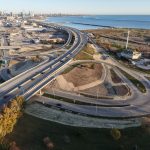How One-way Streets are Inefficient
All the city news you can use.
Every day at The Overhead Wire we sort through over 1,500 news items about cities and share the best ones with our email list. At the end of the week, we take some of the most popular stories and share them with Urban Milwaukee readers. They are national (or international) links, sometimes entertaining and sometimes absurd, but hopefully useful.
Sticks not carrots to get people out of cars: In a new study published in Case Studies on Transport Policy, climate scientists ranked 12 different methods for reducing car use from 800 different studies. What they found was that sticks, not carrots yielded the best results. Policies such as congestion pricing make the cost of driving more visible unlike the costs that are often unseen like air pollution, traffic violence, and public health impacts. (Carlton Reid | Forbes)
Cooling centers underused: As climate change creates more extreme heat events, more and more cities are focusing on strategies to keep people cool. One of those solutions is the cooling center where people can go and get access to air conditioning. But the cooling centers are often underused because they don’t meet people’s needs or requires transportation that people don’t have or can’t access on extremely hot days. If the cooling center is going to work, it needs to be a part of people’s regular routine. (Jake Bittle | Grist)
Colombian activists want better sidewalks: In Bogota, 33% of trips are walking trips. But because of the often rainy weather, the infrastructure for walking is damaged and pose a hazard. Colombian activists upset at the bad sidewalks and pavement conditions have started painting a pink x on damaged concrete. They hope that shame will lead to fixes to necessary infrastructure. (Manuel Rueda | PRI’s The World)
Increased state capacity lowers costs: New research takes a look at how state capacity impacts road paving projects and finds that when there are less public employees at State DOTs, costs increase due to having to outsource work to consultants. The consultants increased and the number of paving companies decreased leading to higher bids and higher cost projects. This suggests that hiring more public sector workers in many different sectors could lower overall costs of projects. (David Dayen | The American Prospect)
Quote of the Week
We turned into a city of cynics who measured every project with a standard formula: take the announced budget and schedule, multiply by 2.5 — then expect worse.
–Josh Freed in Montreal Gazette discussing the feeling the population of Montreal had before completing its latest big project faster and better.
This week on the podcast, we’re sharing part 1 and 2 of a one-to-one conversation between David Longoria of LISC in Phoenix and Ryan Winkle of RAIL CDC. They discuss the community work they are doing in Mesa along the light rail line and the impact their work has on local businesses.
Want more links to read? Visit The Overhead Wire and signup.
If you think stories like this are important, become a member of Urban Milwaukee and help support real, independent journalism. Plus you get some cool added benefits.
Urban Reads
-
How Traffic Noise Impacts Children’s Brains
 Jul 1st, 2024 by Jeff Wood
Jul 1st, 2024 by Jeff Wood
-
Number of Super Commuters is Rising
 Jun 22nd, 2024 by Jeff Wood
Jun 22nd, 2024 by Jeff Wood
-
Why Has the Walkable City Been Villainized?
 Jun 9th, 2024 by Jeff Wood
Jun 9th, 2024 by Jeff Wood






















This article uses a photo of Prospect Avenue as an example of a what could be a Milwaukee one way street. But Prospect has serious limitations as to suitability for conversion. Density of housing, with a great number of apartments, already results in trash and recycling pickups six days a week. There would be frequent moving vans which typically double park, blocking a traffic lane. These would impede traffic and not increase safety. Automobiles and large trucks entering and exiting the many driveways are already disruptive and a possible source of accidents.
How can a six foot wide lane for a Southbound bike lane be added, as it is already cramped with parking and two traffic lanes. Think of the impact if the City were to remove a parking lane; this would be a highly unpopular move.
Between Albion and Brady, a distance of .22 miles, there is no cross street and no crosswalk. (This is the more than the four block distance between Water and Jefferson on Wisconsin Avenue.) When pedestrians have to walk far between cross streets they often cross at mid-block as is routinely seen on Prospect. On a one way street this is unsafe, but you can see all oncoming cars. On a two way street you have to stop in the between traffic lanes, so crossing is much more precarious.
The City recently changed the speed limit on this part of Prospect from 30 to 25 miles per hour, a welcome step in improving pedestrian safety. Changing Prospect to a two way street would increase risks for pedestrians and would not be welcome.